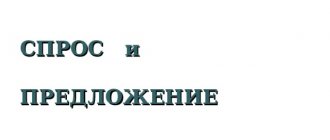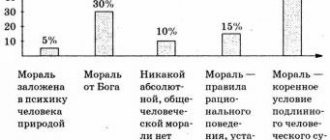Assignments on the topic “Economics” for completing assignments 26-31 (OGE, social studies, grade 9).
26.
Make a plan for the text.
To do this, highlight the main semantic fragments of the text and title each of them. In the correct answer, the points of the plan must correspond to the main semantic fragments of the text and reflect the main idea of each of them.
The following semantic fragments can be distinguished:
1) the essence of private property;
2) features of private property psychology;
3) the influence of private property on society;
4) the role of the state in limiting private property.
It is possible to formulate other points of the plan without distorting the essence of the main idea of the fragment, and to highlight additional semantic blocks.
27. What is private property? Using the text, explain why private property is a condition of a free market.
Private property is not just property... but economic relations between people”; this means that a person treats property as “his own,” that is, he acts as the owner, possessor or full-fledged manager. As an explanation of why private property is a condition of the free market, the following can be given: “by separating themselves from others, private owners strive to obtain more and more of life’s goods into their possession, use and disposal. But in order to get them, they are forced to produce goods for others, receiving in exchange everything they need.”
The definition of private property and explanation can be given in other, similar formulations
28. How is private property psychology characterized in the text? What, according to the author, is the foundation for the formation of an independent personality?
In the text, private property psychology is characterized as the psychology of economic activity and entrepreneurship.
According to the author, the foundation for the formation of an independent personality is “possessing something of one’s own, one’s own, even if it’s very small.”
The specified elements of the answer can be given in other, similar in meaning formulations
29. What types of private property are mentioned in the text? Using social science knowledge, name the types of private property.
The text talks about the following types of private property: individual property, family property; ownership of land, objects and tools, goods. The following types of private property can be named: labor (farming), individual (labor property), non-labor (property of slave owners, feudal lords, etc.). Other types of private property may be named
30. Talking about private property in class, the student noted that this property is the basis of the market and stimulates the development of production and the progress of society. Therefore, there is no point in restraining the strengthening of private property in a modern market economy. Not all students in the class agreed with this opinion. Which of these two points of view is reflected in the text? Provide a piece of text that helps answer the question.
The correct answer must contain the following elements:
1) answer to a question, for example:
in a modern market economy, the manifestation of the negative qualities of private property (excessive selfishness, acquisitiveness, purely personal gain, etc.) is restrained by the state thanks to a number of restrictions that prevent private property from causing damage to consumers and the interests of society.
The answer to the question can be given in a different formulation that is similar in meaning.
2) a piece of text, for example:
“...in a market economy, the state strives to ensure that some of the benefits remain publicly available to everyone and are in public, state, municipal (local) ownership”
31. Do you agree that private property “stimulates initiative and independence, revitalizes the economy, increases interest in more efficient, economical management of the economy,” that is, the advantages of private property outweigh its disadvantages? Based on the text and social science knowledge, give two arguments (explanations) in defense of your position.
The correct answer must contain the following elements:
1) the student’s opinion is expressed: agreement or disagreement with the given point of view;
2) two arguments (explanations) are given in defense of your choice, for example:
if you agree with the above point of view, it may be stated that
— private property acts as the material basis for a person’s independence from the state. Individualism presupposes an orientation toward self-realization and cooperation, which means private property cements society;
- private property can make society rich, since it encourages work and stimulates economic entrepreneurship;
in case of disagreement, it may be stated that
- private property creates inequality between people, therefore a society where private property dominates is anti-democratic;
— private property leads to the fact that a person turns from a goal of development into a means of development, since everything is subordinated to making a profit.
Other arguments (explanations) may be given.
OGE. Social science. THEORY according to the codifier. Economy. 3.6 Market and market mechanism.
3.6 Market and market mechanism.
Plan.
- The essence of the concept of “market”.
- Market mechanism.
- Conditions for the emergence of a market and its characteristics.
- Market functions.
- Types of markets.
- Demand, supply, price.
- The "invisible hand" of the market.
- Competition, its levels, types, conditions.
- Advantages and disadvantages of a market economy.
Market.
A market is an economic relationship associated with the purchase and sale of goods and services, as a result of which product, supply and price are formed.
A market in the narrow sense is the relationship between a seller and a buyer for the purchase and sale of goods at a specific moment in a specific place.
The market mechanism is a mechanism for the formation and distribution of resources, a mechanism for interaction between sellers and buyers regarding the setting of prices and quality, production volume and its structure.
Conditions for the emergence of a market
- Private property
- Freedom of enterprise
- Personal interest of market participants
- Competition
- Free pricing
- Social division of labor
Signs of the market.
- Dominance of private property with equal rights to forms of ownership.
- Maximum freedom of economic activity. Sellers are free to choose the product and place of sale, everything that is permitted by law. The manufacturer is free to produce whatever seems beneficial to him and that is permitted by law.
- Active accounting of supply and demand.
- Unregulated price.
- Unregulated demand.
- Unregulated supply.
- Free pricing.
- Presence of competition.
Market functions.
- Intermediary – connects sellers and buyers
- Pricing – the price is formed in accordance with the laws of the market, that is, supply and demand
- Informational – on the market you can get complete information about the manufacturer, product, seller.
- Regulatory - thanks to supply and demand, a balance of goods and services is established
- Sanitizing – the market is freed from ineffective producers and sellers.
- Stimulating – the introduction of new technologies to improve the quality of products and services, otherwise you may find yourself uncompetitive in the market.
Types of markets
Types of markets in relation to the law
- Legal (that is, officially issued)
- Illegal (or shadow, has no legal basis for activity)
Reasons for the emergence of illegal markets
- Sale of prohibited goods (drugs, poisons, weapons)
- Selling low-quality or expired goods
- Reluctance to pay taxes
Types of markets by degree of regulation:
- Regulated (government controlled)
- Unregulated (government does not interfere).
Types of markets by goods and services offered
- Consumer goods and services (clothing, food, furniture, hairdressing services, etc.)
- Sale of production factors (land, minerals, timber, technical resources, etc.)
- Labor market (places for employment, vacancies)
- Market of scientific and technical developments and innovations
- Market of means of production (machinery, equipment)
- Currency market
- Information market (particularly widespread with the advent of the Internet)
- Market of intellectual products (products of spiritual activity)
- Investment market (that is, long-term investments)
Types of markets by territorial basis
- Local (urban, rural)
- National (Russian)
- Regional (European)
- World
Types of markets by competition
- Market of free or perfect competition
- Imperfectly competitive market or monopolistic market.
Types of markets by subjects entering into exchange
- Consumer market
- Manufacturers Market
- Wholesalers market
- Government services market
Types of markets according to the degree of saturation of goods
- Equilibrium
- In short supply
- Excess
Basic laws of the market
Law of Demand
Demand is the consumer’s desire and ability to purchase a specific product or receive a service.
The law of demand states : the higher the price, the lower the demand, and the lower the price, the higher the demand.
Quantity demand is the quantity of goods and services that a buyer is willing and able to purchase at a given price at a given time.
Demand depends
- From cash income of buyers
- On the size of the market (the larger the market size, the less demand for your product will be).
- From benefits to consumers (various discounts, promotions increase demand)
- Subjective tastes of the population (for example, residents of coastal cities prefer seafood, while in the center of Russia they are in less demand).
- Availability of substitute goods (some product costs significantly more than its substitute, then preference is given to the cheaper one, for example, oranges and tangerines, tea and coffee).
Law of supply
Supply is the desire and ability of the manufacturer to sell a specific product or service.
Law of supply: the higher the price, the higher the supply; the lower the price, the lower the supply.
Quantity supplied is the quantity of goods and services that a producer can offer at a given price at a given time.
Offer depends
- From resource prices (for example, electricity prices increased, supply decreased, as the entrepreneur’s expenses increased)
- From taxes
- From substitute products on the market
- From the quantity of similar products on the market
- On the level of technical progress and the degree of its use by entrepreneurs
Price
Price is the monetary expression of the value of a product on the market.
It can be equal to the cost of the product, be higher or lower than it.
Price is the amount of money that a buyer is willing to pay and a seller is willing to receive for a particular product.
The demand price is the maximum price at which a buyer can purchase a product.
The offer price is the minimum price at which an entrepreneur can sell a product.
Market price - (or it is called the equilibrium price) - the price at which the volume of demand is equal to the volume of supply.
Scarcity – demand is higher than supply.
A surplus of goods means demand is lower than supply.
Profit is the excess of revenue from sales of goods over the total costs of their production and sale.
Market equilibrium is a situation in the market when the seller can and wants to sell exactly only the goods and at the same price as the buyer wants and can buy for this price.
The price at which the real deal is concluded is the equilibrium price.
The "invisible hand" of the market.
The situation in which market participants strive to improve the welfare of all, as each seller and each buyer seeks to satisfy self-interest in their well-being, was called the “invisible hand” of the market by the famous English economist Adam Smith. It is precisely this that forces everyone to think about the interests of others, because otherwise the result of labor may turn out to be unnecessary and, instead of benefits, bring losses. The "invisible hand" of the market directs the desires of individual producers for the common good.
This is how the market works - each participant in the economy, in pursuit of his personal gain, ultimately increases the wealth of the country and serves the interests of the entire society.
Competition.
Competition (from Latin: collide, compete) is the economic rivalry of participants in economic activity in the struggle to achieve better results.
Levels of competition:
- among manufacturers for growth in production volume, rapid reduction of costs, improvement of product quality;
- among consumers for profitable allocation of their income: selection of goods and services of better quality at a lower price;
- between sellers and buyers has the greatest impact on the value of equilibrium prices: sellers want to sell the product at a higher price, and buyers want to buy it at a lower price.
Types of competition (types of markets by competition)
Free (perfect, pure) - a market in which independent, freely operating producers sell identical (standardized) products, none of them is able to control the retail price.
Conditions for free competition:
- Small volume of production from individual manufacturers, which does not allow influencing the price of the product
- Product homogeneity
- Unrestricted access and exit from the market
- Sellers of goods do not influence each other in any way, everyone works independently
Imperfect competition.
- Monopolistic (from the Greek one + sell) is a market in which numerous sellers sell similar, but not identical goods.
- Oligopoly (from the Greek several + sell) is a market dominated by several large firms.
- Pure monopoly - a market in which there is only one seller
Features of imperfect competition:
- Division of the market between large companies
- Restricting the independence of market participants
- Control of market segments (market segments are groups that have similar characteristics, for example, the same product).
- Using unfair methods of competition
Advantages and disadvantages of a market economy.
Advantages.
- Stimulating entrepreneurship and interest in work.
- Rejection of unnecessary and ineffective production.
- Greater rights for producers and consumers.
- No need for a large management team
- Efficient use of resources in accordance with the market mechanism - the laws of supply and demand - the “invisible hand of the market”.
- The presence of competition leading to improved quality of products and services.
- New products appearing on the market
- Widespread use of new production technologies
Flaws.
- Strengthening social differentiation, that is, inequality.
- Economic instability, frequent crises, inflation, unemployment.
- Lack of interest in the development of low-profit, but necessary for society production.
- A ruthless, consumerist attitude towards nature.
- Manufacturer's focus on paying customers.
- Insufficient funding for social spheres, for example, education, healthcare.
- Monopolization of the economy leading to decreased competition
Material prepared by: Melnikova Vera Aleksandrovna.



